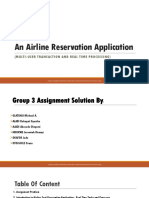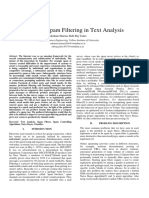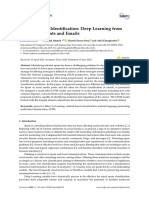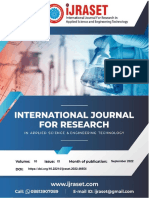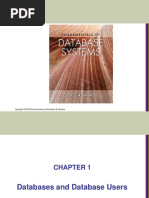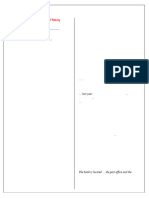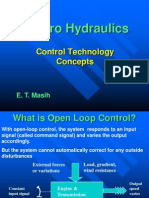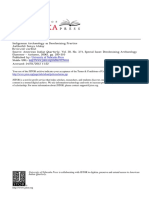Content-Based Sms Spam Filtering Using Machine Learning Technique
Content-Based Sms Spam Filtering Using Machine Learning Technique
Uploaded by
Adio odunolaCopyright:
Available Formats
Content-Based Sms Spam Filtering Using Machine Learning Technique
Content-Based Sms Spam Filtering Using Machine Learning Technique
Uploaded by
Adio odunolaOriginal Description:
Original Title
Copyright
Available Formats
Share this document
Did you find this document useful?
Is this content inappropriate?
Copyright:
Available Formats
Content-Based Sms Spam Filtering Using Machine Learning Technique
Content-Based Sms Spam Filtering Using Machine Learning Technique
Uploaded by
Adio odunolaCopyright:
Available Formats
See discussions, stats, and author profiles for this publication at: https://www.researchgate.
net/publication/325296677
CONTENT-BASED SMS SPAM FILTERING USING MACHINE LEARNING
TECHNIQUE
Article · May 2018
CITATIONS READS
0 771
3 authors, including:
Dipak Kawade Kavita Oza
Sangola College Shivaji University, Kolhapur
13 PUBLICATIONS 19 CITATIONS 56 PUBLICATIONS 38 CITATIONS
SEE PROFILE SEE PROFILE
Some of the authors of this publication are also working on these related projects:
Big Data : A text mining appraoch View project
All content following this page was uploaded by Dipak Kawade on 22 May 2018.
The user has requested enhancement of the downloaded file.
International Journal of Computer Engineering and Applications,
Volume XII, Issue IV, April 18, www.ijcea.com ISSN 2321-3469
CONTENT-BASED SMS SPAM FILTERING USING MACHINE
LEARNING TECHNIQUE
Dr. Dipak R. Kawade1, Dr. Kavita S. Oza 2
1
Department of Computer Science, Sangola College, Sangola (MS) 413307, India
E-mail: dipakkavade@gmail.com
2Department of Computer Science, Shivaji University Kolhapur (MS) 416004, India
E-mail: skavit.oza@gmail.com
ABSTRACT:
In the modern wireless communication world, Short Message Service (SMS) is one of the
important communications way followed by people. It has the powerful economic impact on
the user as well as service provider. Spam SMS is one of the problem faced in this world. Lots
of SMS Spam filtering techniques are used to identify Spam SMS. Present Study focuses on
Spam SMS identification using Machine Learning technique which is implemented using
open source software Python. The experimental result shows that approximately 98 % Spam
SMS’s are identified.
Keywords: Short Message Service (SMS), SMS Spam filtering, Machine Learning, Python
[1] INTRODUCTION
In the wireless communication age, Short Message Service (SMS) is one of the easiest
and affordable communication way. SMS is popular worldwide due to high response rate,
secure, personal service and lowest prize[1]. But there are some problems faced by the people
such as Spam SMS by using this SMS technique. Spammers take advantages of this wireless
world and reach to potential customers. Today most of the SMS’s are Spam SMS which
consists of Credit Card offer, discount offers, traffic plans, promotions etc. Due to Spam
SMS, Mobile service providers suffer from some sort of financial problems as well as it
reduces calling time for users. Unfortunately, if the user accesses such Spam SMS they may
Dr. Dipak R. Kawade and Dr. Kavita S. Oza 625
CONTENT-BASED SMS SPAM FILTERING USING MACHINE LEARNING TECHNIQUE
face the problem of virus or malware. When SMS arrives at mobile it will disturb mobile
user privacy and concentration. It may lead to frustration of user. So Spam SMS is one of the
major issue in wireless communication world and it grows day by day.
To avoid such Spam SMS; people use white and black list of numbers. But this
technique is not adequate to completely avoid Spam SMS. To tackle this problem it is needful
to use a smarter technique which correctly identifies Spam SMS.
Text mining technique is useful for Spam SMS identification. It analyzes text content
and find patterns which are used to identify Spam and Non-Spam SMS. Generally, Spam
SMS filtering is considered as text classification technique. Size of SMS is limited and
normally it is just 160 characters. This SMS includes uppercase as well as lowercase letters,
special symbols, and some URL. Most of Spam SMS includes URL’s, Special characters
such as “$”, “!’ etc.[2] This paper considers all these characters to find features from Bag of
Words in Spam SMS.
SMS Spam identification is Binary classification technique having two types such as
Spam and Ham. In the present study, text classification is used for identification of Spam and
Ham SMS.
In this paper section II focus on related research in SMS Spam filtering area. Section III
discusses experimental work which consists of dataset collection, working environment etc.
Section IV discusses observation of experimental work. Section V presents conclusion and
future work in SMS Spam filtering area.
[2] RELATED WORK
In the paper, a author has focused on SMS Spam filtering. For this purpose, they
considered top email spam filtering techniques on mobile spam. The author used different
email Spam filtering techniques such as TREC etc. The author has not made any decision on
SMS Spam filtering. The author suggested that SMS Spam filtering is critical procedure so
need more experiments and more study of large size dataset. [3]
Author has used WEKA tool for classification of Spam SMS. He has applied different
classification algorithms which are available in WEKAon the basis of accuracy and time. The
output of study showed that FilteredClassifier with unsupervised discredited filter and the
NaiveBayes algorithm has the highest accuracy among other algorithms. [4]
Authors discussed index based text classification method for SMS Spam filtering
technique. They have defined two different models and compared the performance of these
models. Based on different text features, they have implemented six different classification
algorithms and then combined to form collaborative algorithm. Experimental result showed
that classification algorithms performance was increased for English corpus. The result
showed that performance of the word-level index is higher than document level index for the
Chinese language. Time complexity was reduced after applying collaborative learning. [5]
Author has expressed their opinion that; distinguishing characteristics of SMS contents
are not effective or efficient for identifying Spam SMS. In the paper, Author has analyzed
different Spam SMS filtering techniques and identified good algorithm. The experiential
result shows that Bayesian algorithm was best fit for SMS Spam identification. [6]
Dr. Dipak R. Kawade and Dr. Kavita S. Oza 626
International Journal of Computer Engineering and Applications,
Volume XII, Issue IV, April 18, www.ijcea.com ISSN 2321-3469
In the paper, a author has used numerous feature extraction and feature selection
methods for identification of Spam SMS having Turkish and English languages. The Model
framework has considered features from Bag of Words and structural feature for
identification purpose. The Model framework uses different classification algorithm for
classifying Spam SMS. For classification purpose; author uses different combinations of
distinctive features of Bag of Words and Structural feature. Experimental result of the study
shows that combination of Bag of Words and a Structural feature was higher performance
than only using Bag of Words. It has also shown that for each language effectiveness is
different. [2]
In the study; the author has used four different classification algorithms namely Neural
Network (NN), Naïve Bayesian, Support Vector Machine (SVM) and Relevance Vector
Machine (RVM) for classification of Spam SMS. Experimental performance is counted on
the basis of the different size of training dataset and feature extracted size. Author has shown
that NN algorithm is not suitable for Spam SMS identification. Performance of SVM and
RVM algorithm was good but among these two algorithms, RVM is faster than SVM. The
result of the study shows that RVM algorithm is best suited for filtering Spam SMS. [7]
[3] EXPERIMENTAL STUDY
[3.1] Working Environment
This experiment is implemented in Windows 7 operating system with machine
configuration as Intel Core i3, 3.3 GHz, and 2 GB RAM. Python 3.4 is used for this
experiment.
[3.2] B.Dataset
Dataset used in the study is freely available on the internet. It is created by Tiago A.
Almeida and José María Gómez Hidalgo[8]. Dataset consists of a collection of 5568
SMSand 2 attributes. The first attribute is class attribute whereas the second attribute is text
attribute i.e. SMS. Class attribute has two possible values namely Span and Ham. Among
5568 SMS, 746 SMS are of type Spam and 4822 SMS are of Ham type.
[3.3] Python
Python is a programming language developed by Van Rossum and his team. Initially, it
was started in 1989. For present study python 3.4 is used because it is open source and better
community development. Python is downloaded from internet freely. [9] Also it has extensive
library supports, easy learning, and user-friendly etc. and many more advanced feature.
Present study uses NLTK, pandas and re package. Present study uses text mining technique
on SMS text and then cluster into two clusters namely spam and ham.
[3.4] Data Pre-processing
For gaining more accuracy; data must be cleaned. Present dataset consists of SMS text
which is not useful for text processing. Also, SMS consists of stop words i.e. some words are
frequently used such as conjunctions, numbers, prepositions, names, base verbs, etc. Such
Dr. Dipak R. Kawade and Dr. Kavita S. Oza 627
CONTENT-BASED SMS SPAM FILTERING USING MACHINE LEARNING TECHNIQUE
type of words doesn’t play any role in text mining. This unwanted text generates processing
overhead so there is need to clean such data. To achieve this; data pre-processing is
important. Data pre-processing consist of following steps
1. Filtration:-Filtration can remove links, URLs, special words etc.
2. Tokenization:- This step separates text into different tokens.
3. Remove Stopwords:-some words having no any analytical values are removed in this
step, which reduces processing overheads.
4. SteamDocumnet:- This step removes some common ending words such as “ing”,”es”
etc.
5. Remove White Space:- Generally, text contains lots of white spaces, which are
removed in this step.
6. Conversion to lower case:- this step converts all text into lower case letters.
Present study uses regular expression technique for removing white space, numbers etc. from
SMS text. Stopwords are collected and removed by using NLTK package.
[3.5] What is Spam?
Simply Spam SMS is defined as “Unsolicited Bulk Messages”. [6][10]. By using Spam
SMS, unwanted information is posted to user. This information contains some sort of
advertisements, tricks and cheating information.
[3.6] SMS Spam Detection Process
It is very easy to identify Spam SMS just by reading SMS. But our task is to
automatically identify Spam SMS by using some algorithm. This can be achieved by machine
learning technique. Present Study uses machine learning technique to identify Spam SMS.
Present study identifies Spam SMS from SMS data. For detection of Spam SMS; present
study list out words related to Spam in SMS. There are total 225 words listed which are
mostly available in Spam SMS. These words are collected from different web sites as well as
form different SMS.
In initial stage; pre-processing of text has been taken place and generated clear data.
This data then used for Spam detection purpose. Text mining techniques are applied to SMS
text to find bag of words [11] and also counts occurrences of spam word. If count is greater
than 0 then such SMS’s are considered as Spam otherwise it is considered as Ham.
[3.7] Experiment Work
Present study focuses on detection of Spam SMS by using text mining technique. SMS
dataset is pre-processed first to obtain clear data. After pre-processing of SMS data; it counts
Spam word available in each SMS. Depends upon count value obtained by experiment
identifies Spam SMS. If count value greater than 0 then such SMS are considered as Spam.
Following table shows count of Spam SMS from original dataset and present algorithm.
Dr. Dipak R. Kawade and Dr. Kavita S. Oza 628
International Journal of Computer Engineering and Applications,
Volume XII, Issue IV, April 18, www.ijcea.com ISSN 2321-3469
Type Original Dataset count Present Algorithm count
Spam SMS 746 732
Ham SMS 4822 4836
Figure 1:- Shows Spam SMS count obtained by present study algorithm and
original Dataset
Present algorithm correctly identifies 732 spam SMS. Percentage of correctly matching
Spam SMS is 98.12% and mismatching Spam SMS is 1.88%. For finding error rate of
algorithm Mean Absolute Error (MAE) technique is used. A formula for MAE is as follows :
ABS(Predicted − Actual)
MAE =
Total Count
MAE value for present study is 0.091.
Root Mean Square Error (RMSE) is one another important error measure is used for
checking error rate. A formula for RMSE is as follows :
RMSE = √(ABS(Predicted − Actual))/(Total Count))
RMSE value for present algorithm is 0.3.
Following graph shows SMS Spam count of original dataset and count obtained by an
algorithm.
Figure 2:- Shows SMS spam count obtained by present study algorithm and original
dataset
[4] OBSERVATIONS
Present work detects Spam SMS by using text mining technique, which is implemented in
python freeware software. From table 1 and figure 1 it is clearly shown that present work
correctly identifies Spam SMS. The percentage of correct detection of Spam SMS is 98.12
whereas misidentification percentage is 1.88.
For finding errors of algorithm MAE and RMSE techniques are commonly used and values
are 0.091 and 0.3respectively, which are very less. We observed that present work correctly
identifies Spam SMS.
Dr. Dipak R. Kawade and Dr. Kavita S. Oza 629
CONTENT-BASED SMS SPAM FILTERING USING MACHINE LEARNING TECHNIQUE
[5] CONCLUSION
SMS Spam identification is one of the important task in present world, which is
wasting user’s valuable time as well as money. Present algorithm tackles this issue.
Present Work is useful to identify Spam SMS from SMS dataset. Experimental work
shows that 98.12% SMS are identified correctly as Spam SMS’s from the dataset.
It also checks algorithm errors by most important error checking technique MAE and
RMSE. MAE of current algorithm is 0.091 and RMSE is 0.3 which is very less. Therefore
present study correctly identifies Spam SMS’s as compared to other algorithms. There is
more scope to increase accuracy in identifying Spam SMS. The merit of our approach which
lies in the various machine recognizable statistics derived from the skeleton of the document
(HTML tags).
REFERENCES
[1] Delany,S. J., Buckley, M. & Greene, D. (2012) SMS Spam Filtering: Methods and Data, Expert
Systems with Applications, vol. 39 (10),p9899-9908. doi:10.1016/j.eswa.2012.02.053
[2] A. K. Uysal1, S. Gunal1, S. Ergin2, E. SoraGunal , The Impact of Feature Extraction and
Selection on SMS Spam Filtering, , ELEKTRONIKA IR ELEKTROTECHNIKA, ISSN 1392-
1215, VOL. 19, NO. 5, 2013, http://dx.doi.org/10.5755/j01.eee.19.5.1829, pp-67-72
[3] Gordon V. Cormack, José María Gómez Hidalgo, Enrique PuertasSánz, Feature Engineering for
Mobile (SMS) Spam Filtering, SIGIR’07, July 23–27, 2007, Amsterdam, The Netherlands.
ACM 978-1-59593-597-7/07/0007
[4] Dipak R. Kawade, Dr. Kavita S. Oza , SMS Spam Classification using WEKA, , International
Journal of Electronics Communication and Computer Technology (IJECCT), Volume 5 Issue
ICICC(May 2015), www.ijecct.org, ISSN:2249-7838, PP-43-47
[5] WuyingLiu,Ting Wang , Index-based Online Text Classification for SMS Spam Filtering,
JOURNAL OF COMPUTERS, VOL. 5, NO. 6, JUNE 2010, doi:10.4304/jcp.5.6.844-851, PP-
844-851
[6] K. Mathew and B. Issac, "Intelligent spam classification for mobile text message," Proceedings
of 2011 International Conference on Computer Science and Network Technology, Harbin, 2011,
pp. 101-105. doi: 10.1109/ICCSNT.2011.6181918
[7] A comparative study for content-based dynamic spam classification using four machine learning
algorithms,B. Yu, Z. Xu,Knowl. Based Syst. (2008), doi:10.1016/j.knosys.2008.01.001
[8] http://www.dt.fee.unicamp.br/~tiago/smsspamcollection/ Accessed:-03-Aug-2017
[9] https://www.python.org/ Accessed:-03-Mar-2017
[10] Tarek M Mahmoud and Ahmed M Mahfouz, SMS Spam Filtering Technique Based on
Artificial Immune System, IJCSI International Journal of Computer Science Issues, Vol. 9, Issue
2, No 1, March 2012, ISSN (Online): 1694-0814, www.IJCSI.org pp-589-597
[11] Gordon V. Cormack, José María Gómez, Enrique PuertasSánz, Spam Filtering for Short
Messages, Proceeding CIKM '07 Proceedings of the sixteenth ACM conference on Conference
on information and knowledge management Pages 313-320 , doi:10.1145/1321440.1321486
Dr. Dipak R. Kawade and Dr. Kavita S. Oza 630
View publication stats
You might also like
- KS3 Maths Progress Y7 - Revision PackDocument28 pagesKS3 Maths Progress Y7 - Revision PackInas Saleh100% (1)
- An Airline Reservation ApplicationDocument17 pagesAn Airline Reservation ApplicationAdio odunola100% (1)
- DbmsDocument2 pagesDbmsAdio odunolaNo ratings yet
- Homework 2 KeyDocument4 pagesHomework 2 KeyAdio odunolaNo ratings yet
- Case Studies - Operations Research and ManagementDocument12 pagesCase Studies - Operations Research and ManagementVineet NairNo ratings yet
- A Comparative Study For SMS Spam DetectionDocument4 pagesA Comparative Study For SMS Spam DetectionEditor IJTSRDNo ratings yet
- A Systematic Literature Review On SMS Spam Detection TechniquesDocument10 pagesA Systematic Literature Review On SMS Spam Detection Techniquesyasmin lizaNo ratings yet
- SMS Spam Classification Using WEKA: Dipak R. Kawade Kavita S. OzaDocument5 pagesSMS Spam Classification Using WEKA: Dipak R. Kawade Kavita S. Ozayasmin lizaNo ratings yet
- IJCRT23A5429Document7 pagesIJCRT23A5429abhiram2003pgdNo ratings yet
- Solution: March 2018Document8 pagesSolution: March 2018Adio odunolaNo ratings yet
- Survey On Spam Filtering in Text Analysis: Saksham Sharma, Rabi Raj YadavDocument7 pagesSurvey On Spam Filtering in Text Analysis: Saksham Sharma, Rabi Raj YadavAnonymous TpYSenLO8aNo ratings yet
- Vol22 Issue01-253 PDFDocument10 pagesVol22 Issue01-253 PDFsuganthi sNo ratings yet
- A Deep Analysis On Prevailing Spam Mail Filteration Machine Learning ApproachesDocument8 pagesA Deep Analysis On Prevailing Spam Mail Filteration Machine Learning ApproachesEditor IJTSRDNo ratings yet
- Survey On Spam Filtering in Text Analysis: Saksham Sharma, Rabi Raj YadavDocument7 pagesSurvey On Spam Filtering in Text Analysis: Saksham Sharma, Rabi Raj YadavAnonymous TpYSenLO8aNo ratings yet
- Figure 1Document5 pagesFigure 1Hatim LakhdarNo ratings yet
- IJNRD2403165Document5 pagesIJNRD2403165HardikNo ratings yet
- Spam Message Detection Using Logistic RegressionDocument4 pagesSpam Message Detection Using Logistic RegressionInternational Journal of Innovative Science and Research TechnologyNo ratings yet
- Spam Mail Detection Using Machine LearningDocument5 pagesSpam Mail Detection Using Machine LearningIJRASETPublicationsNo ratings yet
- ReportDocument19 pagesReportyashpatelykpNo ratings yet
- VBK23 Cse 041Document6 pagesVBK23 Cse 041preetraj710No ratings yet
- Multi-Purpose Chat Bot: Team Formation Team MembersDocument15 pagesMulti-Purpose Chat Bot: Team Formation Team MembersShubham ChaudharyNo ratings yet
- Email Based Spam DetectionDocument5 pagesEmail Based Spam DetectionRahulNo ratings yet
- Machine Learning Paper-2Document4 pagesMachine Learning Paper-2Bilal AkmalNo ratings yet
- Information: Malicious Text Identification: Deep Learning From Public Comments and EmailsDocument19 pagesInformation: Malicious Text Identification: Deep Learning From Public Comments and Emailsasmm.rahamanNo ratings yet
- Using Support Vector Machine For Classification and Feature Extraction of Spam in EmailDocument7 pagesUsing Support Vector Machine For Classification and Feature Extraction of Spam in Emailghazy almutiryNo ratings yet
- Spam Detection SynopsisDocument8 pagesSpam Detection Synopsisdrishtilalwani20551No ratings yet
- A Multi-Layer Architecture For Spam-Detection System: Conference PaperDocument9 pagesA Multi-Layer Architecture For Spam-Detection System: Conference PaperKarthikhaKVNo ratings yet
- Spam Detection ThesisDocument6 pagesSpam Detection Thesiszyxnlmikd100% (2)
- ETCW15Document4 pagesETCW15Editor IJAERDNo ratings yet
- Major-Final Research PaperDocument3 pagesMajor-Final Research Paperdrishtilalwani20551No ratings yet
- Detection of Spams Using Extended ICA & Neural NetworksDocument6 pagesDetection of Spams Using Extended ICA & Neural NetworksseventhsensegroupNo ratings yet
- Journal PaperDocument7 pagesJournal PaperClash ClanNo ratings yet
- Spam Email Using Machine LearningDocument13 pagesSpam Email Using Machine LearningushavalsaNo ratings yet
- Base PaperDocument22 pagesBase Paperandirajukeshavakrishna6945No ratings yet
- Future Generation Computer Systems: Pradeep Kumar Roy Jyoti Prakash Singh Snehasish BanerjeeDocument10 pagesFuture Generation Computer Systems: Pradeep Kumar Roy Jyoti Prakash Singh Snehasish BanerjeeJosé PatrícioNo ratings yet
- Computers 12 00196 v3Document25 pagesComputers 12 00196 v3urtanisha602No ratings yet
- 1221am - 4.EPRA JOURNALS 13115Document9 pages1221am - 4.EPRA JOURNALS 13115Sathvik S MoolyaNo ratings yet
- Considering Behavior of Sender in Spam Mail Detection: S. Naksomboon, C. Charnsripinyo and N. WattanapongsakornDocument5 pagesConsidering Behavior of Sender in Spam Mail Detection: S. Naksomboon, C. Charnsripinyo and N. WattanapongsakornRavi PurneNo ratings yet
- Spamemaildetectionusingmachinelearningppt 230201113400 20a802e7Document21 pagesSpamemaildetectionusingmachinelearningppt 230201113400 20a802e7cbnsah111No ratings yet
- SaurabhDocument26 pagesSaurabhsaurabhNo ratings yet
- Analysis of Spam Email Filtering Through Naive Bayes Algorithm Across Different DatasetsDocument4 pagesAnalysis of Spam Email Filtering Through Naive Bayes Algorithm Across Different DatasetsInternational Journal of Innovative Science and Research TechnologyNo ratings yet
- A Comprehensive Overview On Intelligent Spam Email DetectionDocument8 pagesA Comprehensive Overview On Intelligent Spam Email DetectionIJRASETPublicationsNo ratings yet
- E-Mail Spam Detection and Classification Using SVM and Feature ExtractionDocument5 pagesE-Mail Spam Detection and Classification Using SVM and Feature ExtractionUthra RamanNo ratings yet
- Thesis On Spam DetectionDocument4 pagesThesis On Spam Detectionalisoncariassiouxfalls100% (2)
- Analysis of Email Fraud Detection Using WEKA ToolDocument5 pagesAnalysis of Email Fraud Detection Using WEKA ToolseventhsensegroupNo ratings yet
- Email Spam Classification Using Hybrid Approach of RBF Neural Network and Particle Swarm OptimizationDocument12 pagesEmail Spam Classification Using Hybrid Approach of RBF Neural Network and Particle Swarm OptimizationAIRCC - IJNSANo ratings yet
- Final PPTDocument18 pagesFinal PPTSumit MajukarNo ratings yet
- Ijresm V6 I9 3 2Document5 pagesIjresm V6 I9 3 2alpegambarliNo ratings yet
- 0_SPAM MAIL PREDICTIONDocument29 pages0_SPAM MAIL PREDICTIONarunanirmal2004No ratings yet
- Email Filter For Spam Mail: A ReviewDocument5 pagesEmail Filter For Spam Mail: A ReviewInternational Journal of Application or Innovation in Engineering & ManagementNo ratings yet
- Email Spam PDFDocument5 pagesEmail Spam PDFOmer ErçelNo ratings yet
- Presentation 3Document13 pagesPresentation 3ragavaharish463No ratings yet
- Email Spam Detection Using Naïve Bayes AlgorithmDocument5 pagesEmail Spam Detection Using Naïve Bayes AlgorithmIJRASETPublicationsNo ratings yet
- (KAVYA R SHETTY)Document21 pages(KAVYA R SHETTY)Kavya ShettyNo ratings yet
- Spam Filtering Based On Latent Semantic Indexing: January 2008Document10 pagesSpam Filtering Based On Latent Semantic Indexing: January 2008Adriana LeonteNo ratings yet
- SMSSpam Detectionusing Deep Neural IJPAMDocument13 pagesSMSSpam Detectionusing Deep Neural IJPAMYashu BajajNo ratings yet
- Synopsis OnDocument8 pagesSynopsis OnzauqafreenNo ratings yet
- Iccs 2020 Published PaperDocument9 pagesIccs 2020 Published PaperRamalingam H MNo ratings yet
- AnchaloraDocument29 pagesAnchaloramaxofficial589No ratings yet
- Research Paper Spam DetectionDocument4 pagesResearch Paper Spam Detectiondrishtilalwani20551No ratings yet
- email reportDocument15 pagesemail reportDANGER ABNo ratings yet
- SMS Classification: Conjoint Analysis of Multinomial Naive Bayes ApplicationDocument9 pagesSMS Classification: Conjoint Analysis of Multinomial Naive Bayes ApplicationIJAR JOURNALNo ratings yet
- Spam email. ClassifierDocument44 pagesSpam email. Classifiermoammadmc23048No ratings yet
- A Novel Method of Spam Mail Detection Using Text Based Clustering ApproachDocument11 pagesA Novel Method of Spam Mail Detection Using Text Based Clustering ApproachHitesh ವಿಟ್ಟಲ್ ShettyNo ratings yet
- SpamAssassin: A practical guide to integration and configurationFrom EverandSpamAssassin: A practical guide to integration and configurationNo ratings yet
- 2020 Convocation List Camera Ready Current StudentsDocument10 pages2020 Convocation List Camera Ready Current StudentsAdio odunolaNo ratings yet
- DFA Minimization Based On Hopcroft's Algorithm Along With Slides On Brzozowski's Algorithm Also Found in Lecture 5Document40 pagesDFA Minimization Based On Hopcroft's Algorithm Along With Slides On Brzozowski's Algorithm Also Found in Lecture 5Adio odunolaNo ratings yet
- Learning Edition Via Blue Prism Digital Exchange (DX) Install Blue Prism Install Blue Prism LicenseDocument2 pagesLearning Edition Via Blue Prism Digital Exchange (DX) Install Blue Prism Install Blue Prism LicenseAdio odunolaNo ratings yet
- Chap 1 DatabaseDocument38 pagesChap 1 DatabaseAsif SaeedNo ratings yet
- ModellingDocument10 pagesModellingAdio odunolaNo ratings yet
- Securing The Internet of Things (Iot) : A Security Taxonomy For IotDocument7 pagesSecuring The Internet of Things (Iot) : A Security Taxonomy For IotAdio odunolaNo ratings yet
- Call Center Simulation Modeling: Methods, Challenges, and OpportunitiesDocument10 pagesCall Center Simulation Modeling: Methods, Challenges, and OpportunitiesAdio odunolaNo ratings yet
- Basic Power System Protection - Info 2017Document2 pagesBasic Power System Protection - Info 2017John SmithNo ratings yet
- Pelham Windham News 2-26-2016Document16 pagesPelham Windham News 2-26-2016Area News GroupNo ratings yet
- News SOURCESDocument4 pagesNews SOURCESjadiNo ratings yet
- En PTV Visum Modules 2Document6 pagesEn PTV Visum Modules 2nanggardrNo ratings yet
- CertDocument66 pagesCertRasheedRafiNo ratings yet
- Project Rubric - MN1520Document5 pagesProject Rubric - MN1520Adeena RafiqNo ratings yet
- How To Use A Dumpy LevelDocument2 pagesHow To Use A Dumpy LevelTom KeeganNo ratings yet
- Coade Pipe Stress Analysis Seminar Notes PDFDocument474 pagesCoade Pipe Stress Analysis Seminar Notes PDFAhmad Vawaid Sulthon100% (1)
- LekshmanBabu YRC ReportDocument13 pagesLekshmanBabu YRC ReportPrasanthNo ratings yet
- What Is Zone? How To Setup Zone? What... : Please Click For All Contents Shared by UsDocument23 pagesWhat Is Zone? How To Setup Zone? What... : Please Click For All Contents Shared by UsAndrie Marga PasaribuNo ratings yet
- Is 11315 11 1985Document10 pagesIs 11315 11 1985rajenkoleyNo ratings yet
- LESSON 2 Grade 7 Effective Interpersonal CommunicationDocument13 pagesLESSON 2 Grade 7 Effective Interpersonal CommunicationRussel Ann Neri100% (1)
- 9 CuDocument4 pages9 Cudenizliyeva78No ratings yet
- English10 q3 m8 (Batilona, Ella S.)Document6 pagesEnglish10 q3 m8 (Batilona, Ella S.)Ella BatilonaNo ratings yet
- Board Resolutions SampleDocument32 pagesBoard Resolutions SampleArnel LagatuzNo ratings yet
- Utilitarianism Tim Mulgan 2024 Scribd DownloadDocument62 pagesUtilitarianism Tim Mulgan 2024 Scribd Downloadsterremupoti100% (4)
- Recruitment and Selection Process For GSKDocument24 pagesRecruitment and Selection Process For GSKTM75% (4)
- Risk Management in AgileDocument14 pagesRisk Management in AgileHammad SaeedNo ratings yet
- CalculusI Version2 PDFDocument293 pagesCalculusI Version2 PDFpedro vasielovichNo ratings yet
- E Remittance SolutionDocument6 pagesE Remittance Solutionnayak07No ratings yet
- Frederick W. Taylor BiodataDocument2 pagesFrederick W. Taylor BiodataZirashNo ratings yet
- Imbaba Bridge ReportDocument13 pagesImbaba Bridge ReportOsama Hashem100% (1)
- ENN-Vol 6Document909 pagesENN-Vol 6CarlosNo ratings yet
- Electro Hydraulics: Control Technology ConceptsDocument98 pagesElectro Hydraulics: Control Technology Concepts@nshu_theachiever90% (10)
- Diamondfreezemel32r E82eenDocument11 pagesDiamondfreezemel32r E82eenGILI RELIABILITYNo ratings yet
- CP 1 7x Manual Addendum For ModdersDocument13 pagesCP 1 7x Manual Addendum For ModderssolmyrelNo ratings yet
- Atalay 2006 PDFDocument32 pagesAtalay 2006 PDFMaria Páscoa de SousaNo ratings yet
- FNAPE Applicant AnnexureDocument3 pagesFNAPE Applicant AnnexureSachin KetkarNo ratings yet

